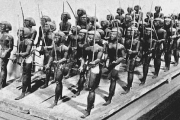Viewings: 6539

In the first quarter of the XIX century the English Hugh Clapperton and brothers Lendery managed to get into the inner region of Nigeria, a country of many Yoruba people. The price of their own lives they studied previously not accessible areas of the African continent, and found there the ruins of the once powerful state, which was called by the name of its capital, located in the extreme North-East of the country. According to legends, the rulers of Oyo once subordinated vast territory, which included almost all of Nigeria, as well as modern Dahomey and Togo. On behalf of one of its peoples inhabiting Oyo called Yoruba.
The Yoruba legend telling that once in the place of the earth was water. Having decided to create a world, God Olorun (host of the sky) dropped from the sky chain, which descended to the ground mythical ancestor of the Yoruba people of Oduduwa. He founded the city of IFE and was in him to rule. He was succeeded by the son of a great warrior, Iranian, which appeared countless offspring. So the city of IFE was the birthplace of humanity.
Within the country Yoruba was prospering trade and crafts. Handicrafts Oyo, especially tissue, was famous far beyond its borders. However, all this remained in the past. European travelers found the state already in a state of deep depression. They passed through a huge fortified town with a population of forty, sixty, a hundred thousand people and was convinced that people have almost forgotten their former skills and achievements. Earthen fortifications were destroyed, moats were overgrown with grass and shrubs along caravan paths scoured units hunters slaves...
Nubian soldiers. Ancient Egyptian culture. XXI century BC
In 1825, almost all members of the expedition of Clapperton, including himself, died from tropical diseases during the hike to the river Niger. Home managed to return only the youngest of travelers - Richard Lander (he was 21). In 1829, was published two-volume work "the last African expedition of Clapperton" and a little later, the three-volume work "Journey to Africa to study the Niger up to his mouth". These works caused in Europe even more interest to the study of the Black continent.
In 1910, a German scientist Leo Frobenius went to a new travel to Nigeria. Long before the arrival in the country he heard legends about Imperial city of IFE from West African slaves, taken away into exile.
In Nigeria Frobenius incredibly lucky. From the very first steps, he was able to make great discoveries, among which was the legendary IFE. On the margins of the dilapidated local Governor's Palace Frobenius first saw lying on the ground pieces of broken reddish-brown, terracotta sculptures depicting the face of a man. In the following days, the expedition found or bartered Africans several terracotta products. Frobenius noticed that the locals quite easily part with sculptures that they once found in the ancient sanctuaries. On clay figures, he said, "these were the traces of very ancient and beautiful art. They are the epitome of symmetry and elegance of form that resembled Ancient Greece and pointed... the existence of an ancient high civilization.
Another significant finding - bronze undoubtedly very ancient and beautiful sculpture - was made a member of the German expedition in the grove dedicated to the sea God sea Yorubskomu. Frobenius recalled: "Before us lay a head of amazing beauty, wonderful cast in bronze, true to its vitality, covered with dark green patina. It was a very olokun, Poseidon Atlantic Africa".
Among other acquisitions the most strange seemed heads gagged mouth, decorated bronze vessels.
The results of the German expedition made a strong impression on scientific and even literary and art circles in Europe. Considerable role in this played a fascinating book of the Leo Frobenius - "Africa speaks" and "Roads of the Atlanteans". The last name is not accidental, but more on that later.
So, at the beginning of the 1990s, before the world of science was commissioned with the mystery of the IFA. Beautiful in its perfection and completeness of bronze and terracotta realistic sculpture portraits of men and women almost life-size. In style they are close to the antique, but facial features sculptures from the IFA typically Negroid. By whom they were created and when?
How originated in the ELISA technique of manufacturing bronze sculptures? Local residents could not give to these questions satisfactorily explained. Archaeologists and art historians were struggling to get their heads on the mystery of their origin. In our time, most scientists believe that the sculptures depict local gods, kings or of the court and, in all probability, originally stood in the altars, where they worshipped in the administration of the cult of ancestors. Obviously, in the ancient IFE believed that the figure ancestor serves as a mediator between the world beyond the grave and real people. Leo Frobenius has promoted its own hypothesis about the origin of the ancient civilization in West Africa, found in Nigeria, has not confirmed and have not been refuted so far.
"I maintain, " he wrote in 1913 after archaeological researches in the IFA that Yoruba with its lush and tropical vegetation, Yoruba, with its chain of lakes on the Atlantic coast, Yoruba, whose characteristic features quite accurately depicted in the work of Plato, this Yoruba is Atlantis, the birthplace of the heirs of Poseidon, God of the sea, called them by Olkonom, country people salty said they extended his authority up to Egypt and the Tyrrhenian sea.
Interestingly, Frobenius saw "the obvious similarity between the Yoruba culture and Mediterranean culture of the ancient Etruscans, as they both have found to be so committed to performance terracotta sculptures, made in similar artistic manner. In addition, Frobenius argued that the Western civilization is the civilization of Atlantis, from Britain to Libya. As for the Yoruba, and the Etruscans, it is still unknown where was the ancestral home of these great Nations, so that, perhaps, it could really be lost Atlantis.
















